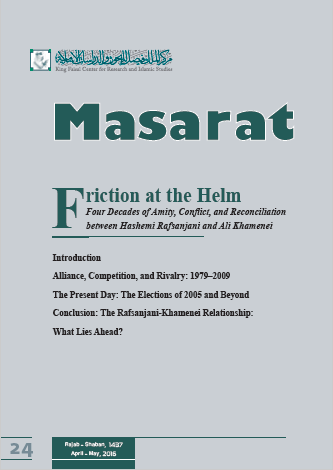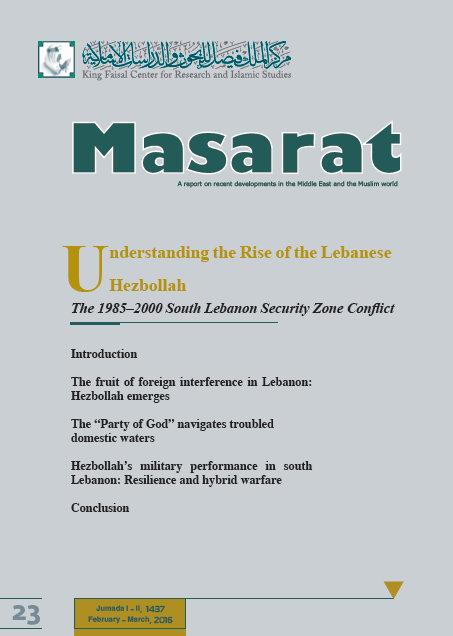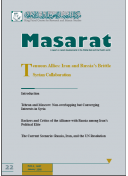Masarat
Number: 32
Author:
Populism is said to be the major new political trend. From Brexit to the election of Donald Trump in the United States, old ideas and conceptions of the Left and Right are being deconstructed before our eyes faced with populist mantras. The French presidential election of 2017 was a story of a pro-European, pro-business, globalist centrist candidate and underdog, Emmanuel Macron, defeating the favored right-wing candidate, decimating the Socialist left, and going on to win a super majority in the National Assembly, with a movement turned-party he only recently created. However, what is not told, are the populist elements and narratives, coopted by all candidates in the French pr
Number:
Author:
On 19 May 2017, the Iranian electorate will go to the polls to choose the next president of the Islamic Republic. The poll will once again give an opportunity for Iranian society to make its views felt, and to choose from amongst a restricted but relatively diverse roster of candidates approved by the clerically-led vetting body, the Guardian Council. The elections are important on a number of levels. They provide society with the chance to approve or reject the significant developments of the last four years, from the rise of the moderate faction headed by the incumbent president, Hassan Rowhani, through to the nuclear deal signed in 2015 and its economic consequences.
T
Number:
Author:
The Iranian political scene has been deeply affected by the sudden passing away of Akbar Hashemi Rafsanjani, the stalwart political figure at the centre of the Islamic Republic's politics since early 1979. His death deprives the political elite of a figure who, while not universally revered, was instrumental in the stabilization and strengthening of the post-revolutionary state order and in solving frequent intra-elite crises. This article will provide an in-depth analysis of Rafsanjani's career, his core beliefs and strategies. In addition, it provides a description of the potential trajec
Number:
Author:
This study investigates minority issues in Syria through the observation of their numbers and geographic locations as well as their economic, political, and social status before and after the outbreak of the Syrian revolution in March 2013, in light of the Syrian authorities’ unwritten proscription of minorities imposed since the country’s independence, and their reluctance to make relevant data accessible to researchers. The research focuses on the impact of the Syrian crisis on minorities both in terms of population presence and political status, as minorities become key players in
Number:
Author:
This article will provide an overview of the reactions which surrounded the publication, in late August 2016, of an audio recording containing a conversation between Ayatollah Montazeri, then successor-in-waiting to Ayatollah Ruhollah Khomeini, and senior officials involved in the execution of thousands of political prisoners in Iranian jails. It will gauge the reaction of various political forces to the publication of the recording, as well as provide statistics pointing to popular interest in it, and assess what political fallout is to be expected from the episode.
Number:
Author:
This study presents a comprehensive portrayal of one of the critical actors in the Syrian arena, and one whose role recently became more prominent: the Syrian Democratic Forces (SDF.) It discusses the conditions that led to its formation, its structure, its funding mechanisms and support, its military capabilities, and its grassroots base. The study also presents maps displaying the SDF’s influence and control in Syria, its areas of influence, and its military tactics, which depend primarily on the People’s Protection Forces (YPG). The study also presents prominent international and regional actors’ positions regarding Syria’s Democrati
Number:
Author:
When Mustafa Hijri, the secretary-general of the Kurdistan Democratic Party of Iran (Hezbî Dêmokiratî Kurdistanî Êran, also known as Partî Dêmokiratî Kurdistanî Êran ), invited young Iranian Kurds to join his party in a speech delivered on March 2016, several Kurdish analysts and activists interpreted his message as an attempt to restart the xebati chekdari, which authorized the use of arms against the government of the Islamic Republic. Others were less convinced. As the Kurdish Democratic Party of Iran (KDPI) has taken up arms in the provinces of Iranian Kurdistan and Iranian A

Number:
Author:
Publication Title: Masarat 24 “Friction at the Helm: Four Decades of Amity, Conflict, and Reconciliation between Hashemi Rafsanjani and Ali Khamenei”
Date of Publication: Rajab – Shaban, 1437 – April – May, 2016.
This issue of Masarat traces the ongoing competition and ideological clash between the Supreme Leader Ayatollah Ali Khamenei, and former president Akbar Hashemi Rafsanjani, which for the past thirty years has had a significant impact on the Iranian political scene. The 24th issue of Masarat focuses on the history of the on-off rivalry between t

Number:
Author:
Publication Title: Masarat 23 “Understanding the Rise of the Lebanese Hezbollah: The 1985-2000 South Lebanon Security Zone Conflict.”
Publication Date: Jumada I – II, 1437, February – March, 2016.
While pundits attribute the Damascene regime’s resilience in the ongoing Syrian conflict largely to the Russian intervention since September 2015, the sudden emergence of the Lebanese Hezbollah on Syrian turf since 2013 has arguably proven to be no less valuable for Bashar al-Assad’s continuous grip on power. This report showcases, by virtu

Number:
Author:
Masarat 22nd Issue, Published January, 2016/Rabi Al-Thani, 1437 Hijri.
This paper aims to discuss the asymmetric, interdependent nature of the relationship between Russia and Iran. The two countries have found themselves on the same side in a variety of conflicts in which their national interests have coincided, and among these conflicts is the current Syrian civil war. The paper discusses the aspects that the alliance on the Syrian issue is based on, the consolidation of this alliance through military synergies between the two countries, and the criticism received by Iran&r
